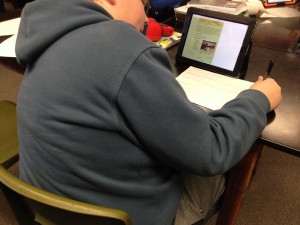Transformative Learning

Planning learning with the end in mind is a time-consuming task, but the results are definitely worth it. As a teacher, you have a clear idea of what learners need to understand and be able to do, based on the standards, and hopefully, how those ideas, concepts, and skills apply to the real world so that students are motivated, engaged, and an authentic performance assessment can be planned.
If the learners are able to transfer their knowledge and skills to a new situation to solve a problem or create something new, the teacher can know beyond the shadow of a doubt that the learners truly understand, and will be able to recall that learning and apply it whenever needed. To me, this is innovative, transformational learning – whether technology is used or not. Quite possibly, an authentic task will require the use of technology – as these are real-world tools. But it is not the focal point of the learning.
Recently, I had the opportunity to observe a group of 6th grade science learners engaged in this kind of transformative learning and performance task. The teacher, Laura Murray, had created a unit using Intel Education Transformation Model – a backwards design process. According to the Colorado Science Standards, students need to be able to understand that objects, processes and events are systems that consist of interacting parts, objects and events can be viewed at various scales, and that change follows patterns that can be directional, predictive, and/or cyclic. Students are to learn about the constructive and destructive earth processes.
Laura’s backwards plan was able to address these understandings and big ideas, and culminated in a performance based assessment where students had the opportunity to apply their understanding in a unique way. Students assumed the role of museum curator –in the far away future. They were able to choose –500,000 or 1,000,000 years in the future! Their task: Create a museum display depicting what the landscape of our area of Colorado might look like in that amount of time.

Prior to this culminating event, the students spent a good deal of time studying geologic periods. You can imagine, to the typical 6th grader, this can seem very abstract – perhaps even a bit dull. But it really came alive for these learners when Laura introduced them to an online resource provided by the Denver Museum of Nature and Science. They featured a special exhibition on Ancient Denvers: The Denver Basin Project. And –the task that they were given within the role of museum curator was exciting, creative, and engaging. Students had a connection because it was about their own landscape that they were challenged to make a prediction. The students worked in teams to research the exhibits the museum currently offered, read the descriptions, and then used their knowledge and understanding to predict their future landscape. This is a 1:1 iPad school, so they used the iPads to research, draw the landscapes for the exhibit, and write up the description for the museum placard.

The day I visited, the students were working specifically on their understanding of scale. Students were using rolls of cash register tape to physically see and understand the time distance between the geologic periods. They used a scale of 1 millimeter = 10,000 years and had to mark them all out on the tape. One of the things I loved about this as that Laura chose the best tool for the task at hand. Trying to create these models of scale using the iPad might have resulted in students not being able to see the physical distance from one mark to the next, and reduced understanding as a result.

What’s next? Seeking authentic feedback from real museum curators at the Denver Museum of Nature & Science. Providing authentic feedback is the finishing embellishment on a unit that provided these 6th grade learners with a transformational learning experience that they may carry with them for a lifetime.
Tools and ideas to transform education. Sign up below.

Laura has been teaching middle schoolers for 13 years at Academy District 20’s Challenger Middle School in Colorado Springs. She has taught Science and Social Studies in 6th, 7th, and 8th grade. She has earned Outdoor Recreation, Business, and Curriculum and Instruction degrees from Colorado State University and University of Colorado at Colorado Springs. In her spare time, Laura coaches Forensics, is a NJHS sponsor, and serves on many school and district committees. Laura also volunteers with theater programs at Challenger and Pine Creek High School.
cross posted at Innovations in Education
Nancy White is the 21st Century Learning & Innovation Specialist for Academy School District 20, providing professional development on 21st century skills and technology integration, and working with the IT-ES team to carry out the district’s 21st Century Learning Plan. Nancy served on an ad-hoc team to help with the integration of 21st century skills into Colorado’s revised content standards, and co-authored The Colorado Learner’s Bill of Rights. Read more at Innovations in Education.
